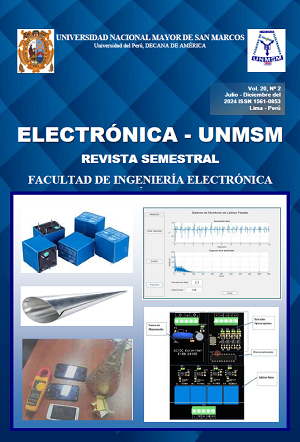Evaluation of the maximum capacity of renewable distributed generation connected to distribution networks to minimize CO2 emissions using methodology based on optimal power flow
DOI:
https://doi.org/10.15381/electron.v20i2.29859Keywords:
Distributed generation, distribution networks, optimal power flow, active network management, wind energy, carbon dioxide (CO2)Abstract
This article presents an evaluation of the maximum renewable distributed generation capacity that can be connected to modern distribution networks (active networks), which include time-varying generation and demand, real-time control device performance and flow. bidirectional power in the lines, to minimize carbon dioxide (CO2) emissions derived from electrical energy generation activities. The optimization methodology used for the evaluation is based on the formulation of an optimal power flow problem (FPO) integrating the active network management (GRA) strategy, which contains schemes such as coordinated voltage control, factor control adaptive power and energy reduction and is applicable in distribution networks with time-varying generation and load characteristics. To solve the optimization problem, the AIMMS modeling and optimization computer program was used.
The results show that very high levels of connection of renewable distributed generation in distribution networks can be achieved to reduce carbon dioxide (CO2) emissions.
Downloads
Published
Issue
Section
License
Copyright (c) 2025 Jose Luis Mejia Olivas, Luis Mark Rudy Ponce Martinez

This work is licensed under a Creative Commons Attribution-NonCommercial-ShareAlike 4.0 International License.

Electrónica - UNMSM by Facultad de Ingeniería Electrónica y Eléctrica de la Universidad Nacional Mayor de San Marcos is licensed under a Creative Commons Attribution-NonCommercial-ShareAlike 4.0 International License.
Based on a work at http://revistasinvestigacion.unmsm.edu.pe/index.php/electron/index.


